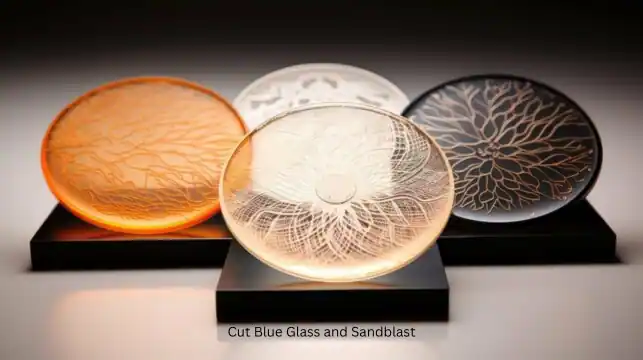When it comes to glass artistry, few materials capture the imagination quite like blue glass. Its vibrant hues can range from deep navy to light azure, making it a favored choice among artists, architects, and interior designers. Cut blue glass and sandblasting techniques further enhance this versatility, allowing for the creation of stunning, customized pieces. In this article, we will explore the intricacies of cut blue glass and sandblasting, discussing their applications, techniques, and the artistry that binds them together.
Understanding Blue Glass: The Color and Its Allure
Blue glass gained popularity centuries ago, often used in stained glass windows, decorative bottles, and various artistic pieces. The color is produced using cobalt oxides or other compounds during the glass-making process, resulting in a range of shades that evoke calmness and serenity. The versatility of blue glass makes it suitable for various applications, from the ornate to the functional.
Types of Blue Glass
When discussing cut blue glass, it’s essential to recognize the different types available:
- Cobalt Blue Glass: Known for its richness and intensity, cobalt blue glass is a popular choice for decorative items, lighting fixtures, and tableware.
- Turquoise Glass: This lighter shade brings a fresh and tropical vibe, often used in coastal-themed decor and jewelry.
- Sky Blue Glass: Featuring softer tones, sky blue glass is commonly utilized in projects that aim to convey tranquility and peace.
The Art of Cutting Blue Glass
Cutting blue glass is an art form in itself. Whether for crafting decorative items, window designs, or functional objects, the cutting technique can dramatically affect the final appearance of the piece.
Tools for Cutting Glass
To achieve precise and clean cuts on blue glass, artists need the right tools:
- Glass Cutter: A handheld tool with a hardened wheel that scores the glass surface.
- Running Pliers: Used to break the glass along the score line.
- CNC Machine: For more intricate, controlled cuts, a Computer Numerical Control (CNC) machine can be employed, allowing for elaborate designs and patterns.
Techniques for Cutting Blue Glass
The cutting process involves careful planning and execution:
- Marking the Glass: Before cutting, the design should be clearly drawn or marked on the blue glass surface. Using a marker that is easy to remove later is advisable.
- Scoring the Surface: With the glass cutter, score the glass by applying even pressure while dragging the cutter across the marked line.
- Breaking the Glass: Using running pliers, align the score line with the edge of the pliers and apply even pressure to break the glass. This process requires a steady hand and practice to achieve satisfactory results.
Sandblasting: An Additional Layer of Artistry
Once the blue glass has been cut, sandblasting offers another dimension to the artistry. This technique can be used to create textures, patterns, or images on the glass surface.
What is Sandblasting?
Sandblasting involves propelling a stream of abrasive material, commonly sand, against the glass surface under high pressure. This process etches designs into the glass, resulting in frosted effects that enhance its visual appeal.
Tools for Sandblasting
The following equipment is essential for sandblasting blue glass:
- Sandblaster: A machine that directs abrasive particles at a controlled pressure towards the glass.
- Abrasive Material: Various materials can be used, including silica sand, aluminum oxide, or glass beads, depending on the desired finish.
- Protective Gear: Safety goggles, gloves, and masks are critical in protecting the user from inhaling dust and abrasive particles.
Sandblasting Techniques
Different techniques can produce various effects:
- Frosting: A uniform etching creates a smooth, frosted glass appearance.
- Clear and Frosted Combination: This technique allows for designs that retain the clarity of the glass while adding frosted textures strategically.
- Deep Etching: A more aggressive technique that removes more material, creating a pronounced texture or design.
Applications of Cut Blue Glass and Sandblasting
The combination of cut blue glass and sandblasting opens a myriad of possibilities across several industries:
Decorative Arts
In decorative arts, artists utilize cut blue glass and sandblasting to create unique sculptures, wall hangings, and ornaments. The interplay of light, color, and texture can transform a simple piece into a striking work of art.
Architectural Features
Many architects incorporate cut blue glass in buildings to reflect natural light, add character, and create stunning visual environments. Sandblasted glass can serve as partitions, windows, or decorative panels, providing both beauty and functionality.
Home Décor
In home décor, cut blue glass pieces can become statement items. From vases and bowls to light fixtures and cabinet doors, using blue glass combined with sandblasting techniques can create personalized, unique elements that complement any home aesthetic.
Maintenance and Care of Cut Blue Glass
After creating beautiful cut blue glass pieces, proper care is essential to ensure longevity:
- Cleaning: Use a soft cloth and a mild detergent solution for cleaning. Avoid abrasive cleaners that could scratch the glass surface.
- Storage: Handle with care and store pieces in padded or cushioned areas to prevent chipping.
- Display: When displaying, avoid direct sunlight for extended periods, as this can affect the color and clarity over time.
Conclusion
Cut blue glass and sandblasting techniques offer a rich and diverse avenue for creativity and artistic expression. Whether you are an aspiring artist, a seasoned glassblower, or an enthusiastic DIYer, understanding the processes associated with cut blue glass creates opportunities for unique artistic creations. As technology and methods continue to evolve, the possibilities for new and innovative designs will only grow, making this beautiful material an enduring favorite among artists and designers alike.

